Books by ISAAC KINGSLEY AMPONSAH
Papers by ISAAC KINGSLEY AMPONSAH
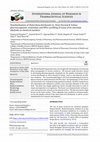
Research paper, 2021
The World Health Organization has encouraged the development of medicinal plant monographs in var... more The World Health Organization has encouraged the development of medicinal plant monographs in various countries. The present study therefore aimed at developing pharmacognostic standards for the quality evaluation of Holarrhena floribunda (G. Don) Durand & Schinz, used as anti-infective in folklore medicine. The macromorphological and micromorphological features, physicochemical, phytochemical and thin layer chromatograms of the leaves and stem bark were evaluated using standard methods. An HPLC method was also developed and validated to profile some steroidal alkaloids of the stem bark. The plant has simple, glaborous leaves, broadly lanceolate to ovate in shape and opposite in arrangement. The leaves were hypostomatic with paracytic
and anomocytic stomata on the abaxial surface. The flat stem bark is light brown on the inner surface. Three alkaloids were profiled as chemical markers for the quality control of the stem bark of H. floribunda, to aid its correct identification for research and industry.
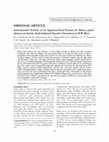
Peptic ulcer disease has and continues to cause high mortality in Ghana and other countries world... more Peptic ulcer disease has and continues to cause high mortality in Ghana and other countries worldwide. This study investigates the anti-ulcerant effect of an aqueous fruit extract of Musa x paradisiaca and its possible receptor site of action to verify and ascertain its traditional use. Phytochemical analyses on the extract revealed the presence of alkaloid, tannins, saponin, glycosides and flavonoids. Thin layer and high performance liquid chromatography analyses performed on the extract to establish fingerprint chromatograms showed four spots and three peaks respectively. Acetic acid-induced (0.2 ml; 8%) gastric ulceration in ICR mice treated with 0.2, 0.4, and 0.8 mg/ kg of the extract and 0.3 mg/kg Esomeprazole significantly decreased the ulcerative index (P ≤ 0.001) and the number of ulcers formed per stomach and increased curative ratio (P ≤ 0.01 -0.001). Histopathological studies of gastric mucosa showed corrections in the architectural distortions caused by the acetic acid-induced ulceration. Contractile effect of histamine on the isolated guinea-pig ileum was significantly inhibited (P ≤ 0.001) by Mepyramine and the extract. The aqueous fruit extract of Musa x paradisiaca has anti-ulcerant property in ICR mice and possibly works as an antagonist to histamine receptors.

ETHNOPHARMACOLOGICAL RELEVANCE:
Leishmaniasis is one of the neglected tropical disease caused by ... more ETHNOPHARMACOLOGICAL RELEVANCE:
Leishmaniasis is one of the neglected tropical disease caused by a protozoan of the genus Leishmania transmitted by sandflies. High cost and lack of oral formulation of existing drugs, rapid developments of resistance by the parasite coupled with serious side effects require new treatments to augment or replace currently available therapies. The major merits of herbal medicine seem to demonstrate perceived efficacy, low incidence of serious adverse effects and low cost. Erythrophleum plants possess beneficial biological properties and, as such, characterization of the bioactive components of these plants is imperative. Previous work has shown an overwhelming presence of cassaine alkaloids in these plants. However, amongst these plants, the African based specie (Erythrophleum ivorense) is the least studied.
OBJECTIVE:
In the current study, the in vitro anti-leishmanial activity of the crude extract, its fractions and isolated compounds were evaluated using direct counting assay of promastigotes of Leishmania donovani using amphotericin B as positive control.
MATERIALS AND METHODS:
The anti-leishmanial activity of E. ivorense extract was evaluated in vitro against the promastigote forms of Leishmania Donovani using a direct counting assay based on growth inhibition. Different crude extracts from ethyl acetate, pet-ether, and methanol as well as pure isolated compounds of E. ivorense: Erythroivorensin, Eriodictyol and Betulinic acid were screened. To know the possible components of the active methanolic extract, attempt was made to elucidate the extract using ultra-performance liquid chromatography quadrupole time of flight mass spectrometry (UHPLC-QTOF-MS/MS).
RESULTS:
This afforded a weak pet-ether fraction, a moderately active ethyl acetate fraction and a significantly active methanol fraction (IC50 = 2.97μg/mL) compared to Amphotericin B (IC50 = 2.40±0.67μg/mL). The novel diterpene erythroivorensin, betulinic acid and the flavanone Eriodictyol, from the ethyl acetate fraction, showed weak activity. UPLC-QTOF-MS/MS was used to identify the cassaine diterpenoids from the active methanol fraction. Here, 10 compounds of this type were putatively identified from the ethanol crude extract.
CONCLUSION:
The fragmentation mechanism of these metabolites is also proposed and are expected to serve as reference template for identification of these and related compounds in future. The presence of these compounds is an indication that they are an inherited and evolutionary component of plants belonging to the Erythrophleum genus. Our results further present another dimension where these compounds and their relative abundances can be used as chemo-taxonomical bio-markers of the genus. The present study also successfully demonstrated/re-affirmed the use of UPLC-QTOF-MS/MS as a robust technique for the characterization of natural products.
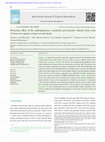
of ethyl acetate extract of the seeds of Senna tora (Syn. Cassia tora) against cowpea weevil
(Cal... more of ethyl acetate extract of the seeds of Senna tora (Syn. Cassia tora) against cowpea weevil
(Callosobruchus maculatus). Methods: The activities were evaluated using standard protocols.
In these bioassays, the cowpea seeds were used directly as an insect feed. The activity of the
extract and isolated compounds were tested at concentrations of 100, 200 and 300 μg/mL and
compared to neem oil and cinnamaldehyde (as standard positive controls). Phytochemical
analysis of the ethyl acetate extract was done through a number of chromatographic techniques
and the structures of the isolated compounds were established through comprehensive
spectroscopic analysis including 2D-NMR and ESI-MS studies. Results: Fractionation
of the active ethyl acetate extract resulted in the isolation of one known anthraquinone,
aurantio-obtusin (1) and a novel compound that was named as cassiatorin (2). Compounds
1 and 2 showed comparable insect antifeedant properties with the positive controls while
their insecticidal and ovipositor deterrent effects were far superior to the standard controls.
Conclusions: It is thus concluded that Senna tora extracts and the isolated compounds (1 and
2) may be employed in the postharvest management of stored cowpea seeds and as other crop
protectants
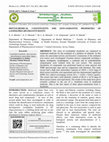
The roots of Landolphia heudelotti are employed in traditional medicine for the treatment of a pl... more The roots of Landolphia heudelotti are employed in traditional medicine for the treatment of a plethora of ailments. In this study, the antioxidant activity and bioactive constituents of the methanol root extract were investigated. Fourteen known compounds including a lignan, neolignans, sesquilignans, a coumarin and an aromadendrane sesquiterpene were isolated from the root extract. The structure elucidation of compounds was performed based on mass spectral and NMR spectroscopic data and by comparison with literature. The crude extract had a high total antioxidant Capacity of 108.8 ± 14.52 mg/g of dried extract (ascorbic acid equivalent) and also demonstrated significant DPPH free radical scavenging activity (IC 50 = 6.956 ± 0.8121 µg/mL). The extract also had a total phenolic content of 98.14 ± 14.70 mg/g of dried extract (tannic acid equivalent). The results of this study have given scientific credence to the use of L. heudelotti roots in traditional medicine. This is the first report of these phyto-constituents from L. heudelotti.
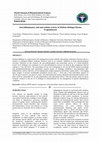
Dialium dinklagei is a plant used in the management of pain, arthritis, rheumatism, pulmonary dis... more Dialium dinklagei is a plant used in the management of pain, arthritis, rheumatism, pulmonary diseases and as a laxative in Ghanaian folklore medicine. However there is no scientific validation of these pharmacological activities. Therefore in this research, the anti-oedematogenic and antioxidant activity of a hydro-ethanolic extract of D. dinklagei was evaluated. In vivo anti-inflammatory activity was done by the carrageenan induced oedema in 7 day old chicks. The antioxidant activity was investigated in vitro by the DPPH radical scavenging and phosphomolybdenum total antioxidant capacity assays. D. dinklagei exhibited a dose-dependent anti-inflammatory activity with ED50 of 10.6 mg/kg body weight compared to diclofenac sodium (ED50 = 4.03 mg/kg body weight). It showed considerable antiradical activity (EC50 = 39.6) and a total antioxidant capacity of 581.58 mg of vitamin C per gram of extract. The phytochemicals tannins, alkaloids and terpenoids present in the plant could be responsible for its anti-inflammatory and antioxidant effects. Thus the present study has given scientific credence to the use of D. dinklagei in ethnomedicine for the management of painful inflammatory conditions
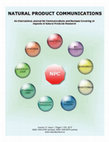
The in vivo antiinflammatory and analgesic activities of the crude ethanol extract and chemical c... more The in vivo antiinflammatory and analgesic activities of the crude ethanol extract and chemical constituents of Clausena anisata roots were investigated. The
crude extract, which was devoid of any visible acute toxicity, displayed significant antiinflammatory effect at the dose of 1000 mg/kg (p.o.) when assessed
using the carrageenan-induced oedema model. In the acetic acid-induced writhing and hot plate tests, it produced a very significant (p < 0.001), dosedependent
analgesic effect, with maximum analgesic activity of 72.1% at 1000 mg/kg (p.o.). Phytochemical analysis of the crude extract resulted in the
isolation of four coumarins (anisocoumarin B, osthol, imperatorin and xanthotoxol) and a carbazole alkaloid, heptaphylline. Among the isolated compounds,
osthol and anisocoumarin B produced the highest antiinflammatory activity at 9 mg/kg (p.o.): slightly better than the positive control, indomethacin. Except
for xanthotoxol, all the isolated compounds administered at 6 mg/kg (p.o.) produced significant analgesic activity and higher than diclofenac; with
heptaphylline being the most potent (48.7%). The analgesic activity of anisocoumarin B (50.4%) was the highest among the isolates tested and the standard,
tramadol, in the hot plate test. The nonselective opioid receptor antagonist, naloxone, abolished the analgesic effect of the crude extract and the tested isolates
(anisocoumarin B and xanthotoxol) in the hot plate test suggesting an effect via the central opioidergic system. These findings provide the scientific basis for
the use of C. anisata roots in traditional medicine as antiinflammatory and analgesic agents.
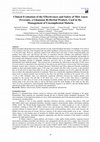
Medicinal plants and products have been used all over the world throughout the history of mankind... more Medicinal plants and products have been used all over the world throughout the history of mankind. Over time in some countries, they have been integrated into the public healthcare system but in the case of Ghana, integration is at the pilot stage. However, questions related to the effectiveness and safety of these medicinal plants and products have been raise and become the bone of contention between orthodox and traditional medicine practitioners. Malaria is a public health problem and continues to be a major cause of morbidity and mortality in most tropical and subtropical countries. The influx of fake medicines and drug counterfeiting have led to malaria parasites becoming resistant to allopathic medicines and have led to an urgent need for new effective antimalarials from medicinal plants. This research was to determine the effectiveness and safety of Mist Amen Fevermix which is a decoction of the stem bark of Morinda lucida and Parinari robusta at the Tafo Government Hospital, Kumasi after Committee on Human Research, Publication and Ethics approval.Clinically established malaria in male and female patients aged, 15-60 years were treated with Mist Amen Fevermix, at the specified dose of 45 mls (0.45 g) three times daily for six days. Parasitaemia clearance was 82.35% within the first three days in clients who responded positively to treatment. There was a statistically significant difference between the mean levels of malaria parasite load recorded at the first visit and those recorded at the second visit, t (34) =12.20, p=.000. Similarly, there was statistically significant difference between the malaria parasite load recorded on the second visit and that of the third visit, t (24) = 2.50, p=.022. This shows a significant effectiveness of Mist Amen Fevermix in the treatment of malaria. Kidney and liver function tests were within normal range at the end of the study as well as full blood count.The main findings of the study are that Mist Amen Fevermix produced by Amen Scientific Herbal Hospital, Kumasi is an effective and safe finished herbal antimalarial product when used as specified by the manufacturer. INTRODUCTION Malaria is a mosquito-borne disease caused by infection with unicellular parasites belonging to the genus Plasmodium. These parasites are transmitted through the bite of infected female Anopheles mosquitoes. The main symptoms of uncomplicated malaria are fever, chills and headache and if left untreated could lead to severe consequences including death. Malaria is one of three globally important infectious diseases, including tuberculosis (TB) and HIV/AIDS which cause substantial morbidity, mortality, negative socioeconomic impact, and human suffering (WHO, 2010). The World Health Organization (WHO) estimates 3.3 billion people are at risk of infection worldwide, resulting in about 500 million clinical cases and around one million deaths per year. Malaria is currently endemic in tropical and sub‐tropical regions of the world including: Africa, Asia, Latin America, the Middle East and some parts of Europe. However, majority of the malaria related deaths occur in sub ‐Saharan Africa where it is the leading cause of mortality for children under the age of five years and pregnant women (WHO, 2008). Therefore, immediate diagnosis, appropriate and effective treatment of the disease is deemed urgent in the fight against malaria. In Ghana, malaria is hyper-endemic and remains a major public health problem, requiring focused interventions including immediate and effective case management and has also been a major cause of poverty and low productivity accounting for about 32.5 percent of all outPatient Department (OPD) attendances and 48.8 percent of under five years admissions in the country (NMCP/ MOH, 2009). It also resulted in 36.9 percent of hospital admissions in 2009 for all ages with more than 80 percent among children alone in Ghana (MOH, 2009).
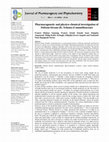
Palisota hirsuta (Family Commelinaceae) is synonymously known as Palisota maclaudii and Dracena h... more Palisota hirsuta (Family Commelinaceae) is synonymously known as Palisota maclaudii and Dracena hirsuta. It is grown as an ornamental plant and a hedge. Ethnopharmacologically, the plant leaf and stem are used as an aphrodisiac, analgesic, antiseptic and in some cases used to treat gonorrhea. The present study was done to develop standardization parameters for the pharmacognostic identification of Palisota hirsuta. All parameters were established according standard procedure. The plant is a robust herb with a fleshy or woody rigid stem bearing soft brown hairs at the base. The leaves are arranged in rosettes with obovate to oblanceolate shape. Transverse sections of the midrib of leaf displayed a double layer of epidermal cells on the adaxial surface and a single layer of epidermal cells on the abaxial side. Powder microscopy of the leaves and stems revealed the presence of abundant acicular calcium oxalate crystals and starch grains. A number of spiral xylem vessels were also present. The ash values, solvent extractives and mineral content of P. hirsuta stem and leaves have also been established. Thus, the present studies has established parameters for the correct identification of P. hirsuta.
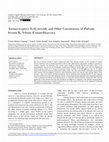
The root of Palisota hirsuta is used in Ghana and other West African countries for the treatment ... more The root of Palisota hirsuta is used in Ghana and other West African countries for the treatment of various disease conditions such as rheumatoid arthritis (also in other inflammatory and painful conditions), infertility in females, anaemia, and dysentery. The current study sought to evaluate the anti-nociceptive effect of the hydroethanolic root extract and compounds isolated from Palisota hirsuta. Mice were used for studying the antinociceptive activity of P. hirsuta extracts and isolates at doses of 10-300 mgkg-1 p.o and 10-30 mgkg-1 respectively using the Formalin Induced paw licking model. The total crude extract, methanolic and petroleum ether fractions showed analgesic activity in a dose-dependent manner for both the early and late phases. Three isolates, a fatty acid mixture, 20-hydroxyecdysone and an uncharacterized ecdysteroid (PH V) were obtained from the methanol fractions with significant activity. 20-hydroxyecdysone exhibited a dose-dependent inhibition of the nociception for both the early and late phases; 71.39±9.19% and 89.19±3.81% respectively. PH V showed significant activity between the early and late phases of inhibition as compared to the reference drug morphine. The present study has given scientific credence to the use of the roots of P. hirsuta for the mitigation of pain and established its antinociceptive constituents.
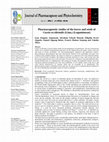
Cassia occidentalis is used in Ghana mainly for the management of hypertension. The aim of the pr... more Cassia occidentalis is used in Ghana mainly for the management of hypertension. The aim of the present studies was to establish standardization parameters for the authentication and quality control of the leaf and seeds of Cassia occidentalis. The macromorphological, qualitative and quantitative features, physicochemical, phytochemical and some spectroscopic features of the medicinally used parts were evaluated using standard methods. The plant was found to be a glaborous herb with compound pinnate leaves. It has 6-8 pairs of leaflets. The leaflets are broadly lanceolate to ovate, with an acute apex and possessing a gland near the base of the leaf rachis. The seeds are ovoid about 4 mm long flattened with a smooth and hard testa. It is amphistomatic with anomocytic stomata. The quantitative indices of the leaf and physicochemical parameters have also been established. A 0.5% ethanol extract of the leaves and seeds showed characteristic UV maxima which may be invaluable in its identification. The pharmacognostic features established in this study may be used as part of a pharmacopoeial standard for the correct identification and quality control of Cassia occidentalis.
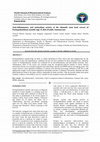
Pachypodantium staudtii Engl. & Diels, is widely distributed in West Africa and used indigenously... more Pachypodantium staudtii Engl. & Diels, is widely distributed in West Africa and used indigenously for the treatment of pain and inflammatory conditions but has not been validated for these purported uses. Ethanolic extract of Pachypodantium staudtii was evaluated for its anti-inflammatory and anti-oxidant activities. Anti-inflammatory effect of the extract was assessed using the carrageenan-induced oedema in chicks whereas antioxidant activity was evaluated using the total antioxidant capacity and DPPH radical scavenging assays. The extract showed a dose dependent inhibition of oedema with maximal percentage inhibition of 68.74% at 300 mg/kg body weight. It also showed significant antioxidant activities. Coumarins, flavonoids, alkaloids and other phytochemicals found in the plant could be responsible for these activities. Thus the present studies have given scientific credence to the folkloric use of P. staudtii for the treatment of pain and inflammation.

The stem- and root-bark of Erythrophleum ivorense (A Chev., family, Fabaceae) are routinely emplo... more The stem- and root-bark of Erythrophleum ivorense (A Chev., family, Fabaceae) are routinely employed in the West African traditional medicine to treat inflammation and a variety of other disease conditions. Although the chemistry and pharmacology of cassaine-type diterpene alkaloids isolated from the stem-bark of the plant are fairly established, the root-bark has not yet been investigated. In the present study, the crude aqueous-alcohol extract of the root-bark was demonstrated to display a time- and dose (30-300 mg/kg p.o.)-dependent anti-inflammatory effect in chicks. Comprehensive chromatographic analysis coupled with spectroscopic and X-ray study further allowed the assignment of one of the major anti-inflammatory constituents as a novel cassaine-type diterpene, erythroivorensin. The other major constituents were known anti-inflammatory compounds: a triterpene, betulinic acid and a flavonoid, eriodictyol. The dose (10-100mg/kg p.o.)-dependent anti-inflammatory effects of the three compounds were either comparable or more significant than the positive control, diclofenac.
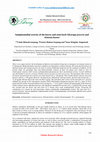
There is an urgent need for the development of effective anti-malarial drugs due to emergence of ... more There is an urgent need for the development of effective anti-malarial drugs due to emergence of resistant strains of P. falciparum. Medicinal plants represent a plethora of compounds to achieve this feat. The stem and leaf extracts of Alstonia boonei and Carapa procera are used in various traditional medicines for the treatment of malaria. In the present study, the petroleum ether and hydro-alcoholic extracts of these two plants were tested in vitro on choloroquine sensitive (3D7) strains of Plasmodium falciparum for their anti-malarial activity. Growth inhibition was determined in vitro by counting GIEMSA-stained parasites by light microscopy. The petroleum ether extract of the leaves and stem bark of A. boonei were both inactive (IC 50 ˃100 µg/ml). Their soxhlet ethanol extracts were also inactive with IC 50 ˃100 µg/ml. However, the leaf extract, obtained by cold maceration, showed weak activity (IC 50 = 71.24 µg/ml) whereas that of the stem was 88.15 µg/ml. The petroleum ether extract of the stem bark of C. procera inhibited the growth of the chloroquine sensitive (3D7) Plasmodium falciparum parasite with IC 50 value of 19.52 µg/ml and the soxhlet extracted ethanol extract giving IC 50 = 11.41 µg/ml. Column chromatography of the bioactive soxhlet ethanol extract afforded fractions with significant antimalarial activities (IC 50 ˂10µg/ml).The present study has revealed that the leaves and stem bark of A. boonei show weak antiplasmodial activity. Extracting the constituents of A. boonei by cold maceration retains considerable antiplasmodial activity. The stem bark of C. procera however, showed significant antiplasmodial activity. Chromatographic fractionation afforded more potent antiplasmodial fractions.
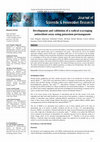
The main objective of the study was to develop and validate a novel radical scavenging antioxidan... more The main objective of the study was to develop and validate a novel radical scavenging antioxidant assay using KMnO4. In this method tannic acid at concentration 6.25 μg/ml – 200 μg/ml was used as the standard antioxidant. KMnO4 solution (80.00 μg/L) in phosphate buffer (pH= 9) was developed as the prooxidant. Absorbances of KMnO4 both in the presence and absence of the antioxidant were taken spectrophotometrically at a wavelength of 526 nm after 30 minutes incubation period. The results obtained were then compared to results from reference method which employs 40.00 μg/L DPPH in methanol prepared and subjected to similar experimental conditions. The results showed that KMnO4 solution prepared in a phosphate buffer (pH= 9), was most stable and had the highest molar absorptivity. The method developed was precise, accurate and specific. The method developed passed all the validation parameters according to the ICH guidelines. This offers a new antioxidant method that is relatively cheap and safe to use.
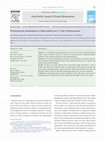
Objective:
To establish the pharmacognostic characters for the correct identification and qualit... more Objective:
To establish the pharmacognostic characters for the correct identification and quality control of Hilleria latifolia (H.latifolia), an important herb in Ghanaian folklore medicine, for the treatment of infections, pain and inflammation.
Methods:
The macro-morphological, qualitative and quantitative microscopic features, physicochemical and phytochemical features of the medicinally used parts of H. latifolia were evaluated using standard methods.
Results:
The plant has simple, alternate leaves with entire margin. The lamina is ovate to broadly lanceolate with an acuminate apex. It is hypostomatic with anomocytic stomata. The plant contains abundant prismatic crystals in all parts. Starch grains abound in the roots. The quantitative indices of the leaf and physicochemical parameters have also been established.
Conclusions:
The pharmacognostic features established in this study may be used as part of the pharmacopoeial standard for the correct identification and quality control of H. latifolia
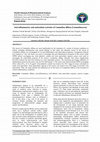
The leaves of Commelina diffusa are used traditionally for the treatment of a variety of disease ... more The leaves of Commelina diffusa are used traditionally for the treatment of a variety of disease conditions in Ghana, including inflammation and wound healing. In this study, the ethanolic extract of the leaves of Commelina diffusa was investigated for its anti-inflammatory and antioxidant properties. Carrageenan induced foot oedema in 7-day old chicks was used to investigate the anti-inflammatory properties of the extract while DPPH radical scavenging test, total phenolic content and total antioxidant capacity assays were used to investigate the antioxidant property of the extract. Commelina diffusa ethanolic leaf extract significantly (P<0.05) reduced the total foot oedema in a dose dependent manner. The maximum percentage inhibition of inflammation given by the extract was 43.55% (300 mg kg
-1). The extract also showed potent DPPH scavenging effect with an IC50 of 11.35 μg/ml. Total phenolic content was found to be 193.7 mg/g of extract calculated as tannic acid equivalent. Total antioxidant capacity of the extract was found to be 130.5 mg/g of (ascorbic acid equivalent). Thus, the study justifies the traditional use of the leaves of Commelina diffusa in the treatment of various inflammatory conditions
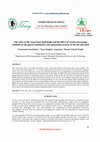
The cocoa bean shell is the major by-product of the cocoa bean during its processing into cocoa p... more The cocoa bean shell is the major by-product of the cocoa bean during its processing into cocoa products. The cocoa bean shell makes about 10 -12 % of the weight of the cocoa bean. Tons of the cocoa bean shell is disposed off as waste every year. Research over the years has been focused on cocoa polyphenols, especially the flavonoids, and its function as potent antioxidant in human health. In this study, the effect of various processing methods on the phytoconstituents (bioactive compounds) and the antioxidant activity of the nib and shell were assessed using the DPPH radical scavenging and total antioxidant capacity assays. All the cocoa samples showed the same trend in antioxidant activity for all the different processing methods. It was seen that micronizing before deshelling of the bean impacts on the nib quality in terms of antioxidant activity as compared to roasting the bean before deshelling. Again, the shell quality in terms of antioxidant activity was better when micronizing was done before deshelling. However, both processing methods still retains some antioxidant potency in the shell and the nib which, in the long term, protects the organism from oxidative damage leading to disease conditions.
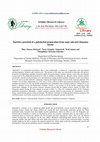
Abemudro' is a polyherbal formulation that is used traditionally in Ghana for recuperation and re... more Abemudro' is a polyherbal formulation that is used traditionally in Ghana for recuperation and rejuvenation during pregnancy, lactation and convalescence. The purpose of this study was essentially to determine the nutritive properties of Nephrolepis undulata, Secamone afzelii, Dracaena mannii, Lantana camara, Costus afer and Solanum torvum used in this polyherbal formulation in order to validate it traditional use. Mineral content, vitamin analysis and protein contents of selected plants were determined according standard methods. Solanum torvum was found to be a rich source of vital minerals; containing relatively the highest amount of most of the minerals analysed. This includes iron (0.34%), magnesium (51.17%), zinc (1.32%), sodium (5.55%) and potassium (49.62%). Nephrolepis undulata was found to be the only herbal component in the combination that contained vitamin A. Vitamin B-12 was found in Solanum torvum and Nephrolepis undulata. Vitamin C was present in all the herbal components except Nephrolepis undulata. In the protein analysis, Solanum torvum had the highest protein content (11.38%) with Dracaena mannii having the least amount of protein (1.44% w / w ). Thus the constituent plants of the Ghanaian polyherbal formulation 'Abemudro', contain essential vitamins, minerals and proteins for maintenance of wellbeing, wound healing and prevention of anaemia. The folkloric technique of combining these herbs is justified as the individual plants, used alone, would not be able to provide the adequate amounts of nutrients.







Uploads
Books by ISAAC KINGSLEY AMPONSAH
Papers by ISAAC KINGSLEY AMPONSAH
and anomocytic stomata on the abaxial surface. The flat stem bark is light brown on the inner surface. Three alkaloids were profiled as chemical markers for the quality control of the stem bark of H. floribunda, to aid its correct identification for research and industry.
Leishmaniasis is one of the neglected tropical disease caused by a protozoan of the genus Leishmania transmitted by sandflies. High cost and lack of oral formulation of existing drugs, rapid developments of resistance by the parasite coupled with serious side effects require new treatments to augment or replace currently available therapies. The major merits of herbal medicine seem to demonstrate perceived efficacy, low incidence of serious adverse effects and low cost. Erythrophleum plants possess beneficial biological properties and, as such, characterization of the bioactive components of these plants is imperative. Previous work has shown an overwhelming presence of cassaine alkaloids in these plants. However, amongst these plants, the African based specie (Erythrophleum ivorense) is the least studied.
OBJECTIVE:
In the current study, the in vitro anti-leishmanial activity of the crude extract, its fractions and isolated compounds were evaluated using direct counting assay of promastigotes of Leishmania donovani using amphotericin B as positive control.
MATERIALS AND METHODS:
The anti-leishmanial activity of E. ivorense extract was evaluated in vitro against the promastigote forms of Leishmania Donovani using a direct counting assay based on growth inhibition. Different crude extracts from ethyl acetate, pet-ether, and methanol as well as pure isolated compounds of E. ivorense: Erythroivorensin, Eriodictyol and Betulinic acid were screened. To know the possible components of the active methanolic extract, attempt was made to elucidate the extract using ultra-performance liquid chromatography quadrupole time of flight mass spectrometry (UHPLC-QTOF-MS/MS).
RESULTS:
This afforded a weak pet-ether fraction, a moderately active ethyl acetate fraction and a significantly active methanol fraction (IC50 = 2.97μg/mL) compared to Amphotericin B (IC50 = 2.40±0.67μg/mL). The novel diterpene erythroivorensin, betulinic acid and the flavanone Eriodictyol, from the ethyl acetate fraction, showed weak activity. UPLC-QTOF-MS/MS was used to identify the cassaine diterpenoids from the active methanol fraction. Here, 10 compounds of this type were putatively identified from the ethanol crude extract.
CONCLUSION:
The fragmentation mechanism of these metabolites is also proposed and are expected to serve as reference template for identification of these and related compounds in future. The presence of these compounds is an indication that they are an inherited and evolutionary component of plants belonging to the Erythrophleum genus. Our results further present another dimension where these compounds and their relative abundances can be used as chemo-taxonomical bio-markers of the genus. The present study also successfully demonstrated/re-affirmed the use of UPLC-QTOF-MS/MS as a robust technique for the characterization of natural products.
(Callosobruchus maculatus). Methods: The activities were evaluated using standard protocols.
In these bioassays, the cowpea seeds were used directly as an insect feed. The activity of the
extract and isolated compounds were tested at concentrations of 100, 200 and 300 μg/mL and
compared to neem oil and cinnamaldehyde (as standard positive controls). Phytochemical
analysis of the ethyl acetate extract was done through a number of chromatographic techniques
and the structures of the isolated compounds were established through comprehensive
spectroscopic analysis including 2D-NMR and ESI-MS studies. Results: Fractionation
of the active ethyl acetate extract resulted in the isolation of one known anthraquinone,
aurantio-obtusin (1) and a novel compound that was named as cassiatorin (2). Compounds
1 and 2 showed comparable insect antifeedant properties with the positive controls while
their insecticidal and ovipositor deterrent effects were far superior to the standard controls.
Conclusions: It is thus concluded that Senna tora extracts and the isolated compounds (1 and
2) may be employed in the postharvest management of stored cowpea seeds and as other crop
protectants
crude extract, which was devoid of any visible acute toxicity, displayed significant antiinflammatory effect at the dose of 1000 mg/kg (p.o.) when assessed
using the carrageenan-induced oedema model. In the acetic acid-induced writhing and hot plate tests, it produced a very significant (p < 0.001), dosedependent
analgesic effect, with maximum analgesic activity of 72.1% at 1000 mg/kg (p.o.). Phytochemical analysis of the crude extract resulted in the
isolation of four coumarins (anisocoumarin B, osthol, imperatorin and xanthotoxol) and a carbazole alkaloid, heptaphylline. Among the isolated compounds,
osthol and anisocoumarin B produced the highest antiinflammatory activity at 9 mg/kg (p.o.): slightly better than the positive control, indomethacin. Except
for xanthotoxol, all the isolated compounds administered at 6 mg/kg (p.o.) produced significant analgesic activity and higher than diclofenac; with
heptaphylline being the most potent (48.7%). The analgesic activity of anisocoumarin B (50.4%) was the highest among the isolates tested and the standard,
tramadol, in the hot plate test. The nonselective opioid receptor antagonist, naloxone, abolished the analgesic effect of the crude extract and the tested isolates
(anisocoumarin B and xanthotoxol) in the hot plate test suggesting an effect via the central opioidergic system. These findings provide the scientific basis for
the use of C. anisata roots in traditional medicine as antiinflammatory and analgesic agents.
To establish the pharmacognostic characters for the correct identification and quality control of Hilleria latifolia (H.latifolia), an important herb in Ghanaian folklore medicine, for the treatment of infections, pain and inflammation.
Methods:
The macro-morphological, qualitative and quantitative microscopic features, physicochemical and phytochemical features of the medicinally used parts of H. latifolia were evaluated using standard methods.
Results:
The plant has simple, alternate leaves with entire margin. The lamina is ovate to broadly lanceolate with an acuminate apex. It is hypostomatic with anomocytic stomata. The plant contains abundant prismatic crystals in all parts. Starch grains abound in the roots. The quantitative indices of the leaf and physicochemical parameters have also been established.
Conclusions:
The pharmacognostic features established in this study may be used as part of the pharmacopoeial standard for the correct identification and quality control of H. latifolia
-1). The extract also showed potent DPPH scavenging effect with an IC50 of 11.35 μg/ml. Total phenolic content was found to be 193.7 mg/g of extract calculated as tannic acid equivalent. Total antioxidant capacity of the extract was found to be 130.5 mg/g of (ascorbic acid equivalent). Thus, the study justifies the traditional use of the leaves of Commelina diffusa in the treatment of various inflammatory conditions
and anomocytic stomata on the abaxial surface. The flat stem bark is light brown on the inner surface. Three alkaloids were profiled as chemical markers for the quality control of the stem bark of H. floribunda, to aid its correct identification for research and industry.
Leishmaniasis is one of the neglected tropical disease caused by a protozoan of the genus Leishmania transmitted by sandflies. High cost and lack of oral formulation of existing drugs, rapid developments of resistance by the parasite coupled with serious side effects require new treatments to augment or replace currently available therapies. The major merits of herbal medicine seem to demonstrate perceived efficacy, low incidence of serious adverse effects and low cost. Erythrophleum plants possess beneficial biological properties and, as such, characterization of the bioactive components of these plants is imperative. Previous work has shown an overwhelming presence of cassaine alkaloids in these plants. However, amongst these plants, the African based specie (Erythrophleum ivorense) is the least studied.
OBJECTIVE:
In the current study, the in vitro anti-leishmanial activity of the crude extract, its fractions and isolated compounds were evaluated using direct counting assay of promastigotes of Leishmania donovani using amphotericin B as positive control.
MATERIALS AND METHODS:
The anti-leishmanial activity of E. ivorense extract was evaluated in vitro against the promastigote forms of Leishmania Donovani using a direct counting assay based on growth inhibition. Different crude extracts from ethyl acetate, pet-ether, and methanol as well as pure isolated compounds of E. ivorense: Erythroivorensin, Eriodictyol and Betulinic acid were screened. To know the possible components of the active methanolic extract, attempt was made to elucidate the extract using ultra-performance liquid chromatography quadrupole time of flight mass spectrometry (UHPLC-QTOF-MS/MS).
RESULTS:
This afforded a weak pet-ether fraction, a moderately active ethyl acetate fraction and a significantly active methanol fraction (IC50 = 2.97μg/mL) compared to Amphotericin B (IC50 = 2.40±0.67μg/mL). The novel diterpene erythroivorensin, betulinic acid and the flavanone Eriodictyol, from the ethyl acetate fraction, showed weak activity. UPLC-QTOF-MS/MS was used to identify the cassaine diterpenoids from the active methanol fraction. Here, 10 compounds of this type were putatively identified from the ethanol crude extract.
CONCLUSION:
The fragmentation mechanism of these metabolites is also proposed and are expected to serve as reference template for identification of these and related compounds in future. The presence of these compounds is an indication that they are an inherited and evolutionary component of plants belonging to the Erythrophleum genus. Our results further present another dimension where these compounds and their relative abundances can be used as chemo-taxonomical bio-markers of the genus. The present study also successfully demonstrated/re-affirmed the use of UPLC-QTOF-MS/MS as a robust technique for the characterization of natural products.
(Callosobruchus maculatus). Methods: The activities were evaluated using standard protocols.
In these bioassays, the cowpea seeds were used directly as an insect feed. The activity of the
extract and isolated compounds were tested at concentrations of 100, 200 and 300 μg/mL and
compared to neem oil and cinnamaldehyde (as standard positive controls). Phytochemical
analysis of the ethyl acetate extract was done through a number of chromatographic techniques
and the structures of the isolated compounds were established through comprehensive
spectroscopic analysis including 2D-NMR and ESI-MS studies. Results: Fractionation
of the active ethyl acetate extract resulted in the isolation of one known anthraquinone,
aurantio-obtusin (1) and a novel compound that was named as cassiatorin (2). Compounds
1 and 2 showed comparable insect antifeedant properties with the positive controls while
their insecticidal and ovipositor deterrent effects were far superior to the standard controls.
Conclusions: It is thus concluded that Senna tora extracts and the isolated compounds (1 and
2) may be employed in the postharvest management of stored cowpea seeds and as other crop
protectants
crude extract, which was devoid of any visible acute toxicity, displayed significant antiinflammatory effect at the dose of 1000 mg/kg (p.o.) when assessed
using the carrageenan-induced oedema model. In the acetic acid-induced writhing and hot plate tests, it produced a very significant (p < 0.001), dosedependent
analgesic effect, with maximum analgesic activity of 72.1% at 1000 mg/kg (p.o.). Phytochemical analysis of the crude extract resulted in the
isolation of four coumarins (anisocoumarin B, osthol, imperatorin and xanthotoxol) and a carbazole alkaloid, heptaphylline. Among the isolated compounds,
osthol and anisocoumarin B produced the highest antiinflammatory activity at 9 mg/kg (p.o.): slightly better than the positive control, indomethacin. Except
for xanthotoxol, all the isolated compounds administered at 6 mg/kg (p.o.) produced significant analgesic activity and higher than diclofenac; with
heptaphylline being the most potent (48.7%). The analgesic activity of anisocoumarin B (50.4%) was the highest among the isolates tested and the standard,
tramadol, in the hot plate test. The nonselective opioid receptor antagonist, naloxone, abolished the analgesic effect of the crude extract and the tested isolates
(anisocoumarin B and xanthotoxol) in the hot plate test suggesting an effect via the central opioidergic system. These findings provide the scientific basis for
the use of C. anisata roots in traditional medicine as antiinflammatory and analgesic agents.
To establish the pharmacognostic characters for the correct identification and quality control of Hilleria latifolia (H.latifolia), an important herb in Ghanaian folklore medicine, for the treatment of infections, pain and inflammation.
Methods:
The macro-morphological, qualitative and quantitative microscopic features, physicochemical and phytochemical features of the medicinally used parts of H. latifolia were evaluated using standard methods.
Results:
The plant has simple, alternate leaves with entire margin. The lamina is ovate to broadly lanceolate with an acuminate apex. It is hypostomatic with anomocytic stomata. The plant contains abundant prismatic crystals in all parts. Starch grains abound in the roots. The quantitative indices of the leaf and physicochemical parameters have also been established.
Conclusions:
The pharmacognostic features established in this study may be used as part of the pharmacopoeial standard for the correct identification and quality control of H. latifolia
-1). The extract also showed potent DPPH scavenging effect with an IC50 of 11.35 μg/ml. Total phenolic content was found to be 193.7 mg/g of extract calculated as tannic acid equivalent. Total antioxidant capacity of the extract was found to be 130.5 mg/g of (ascorbic acid equivalent). Thus, the study justifies the traditional use of the leaves of Commelina diffusa in the treatment of various inflammatory conditions